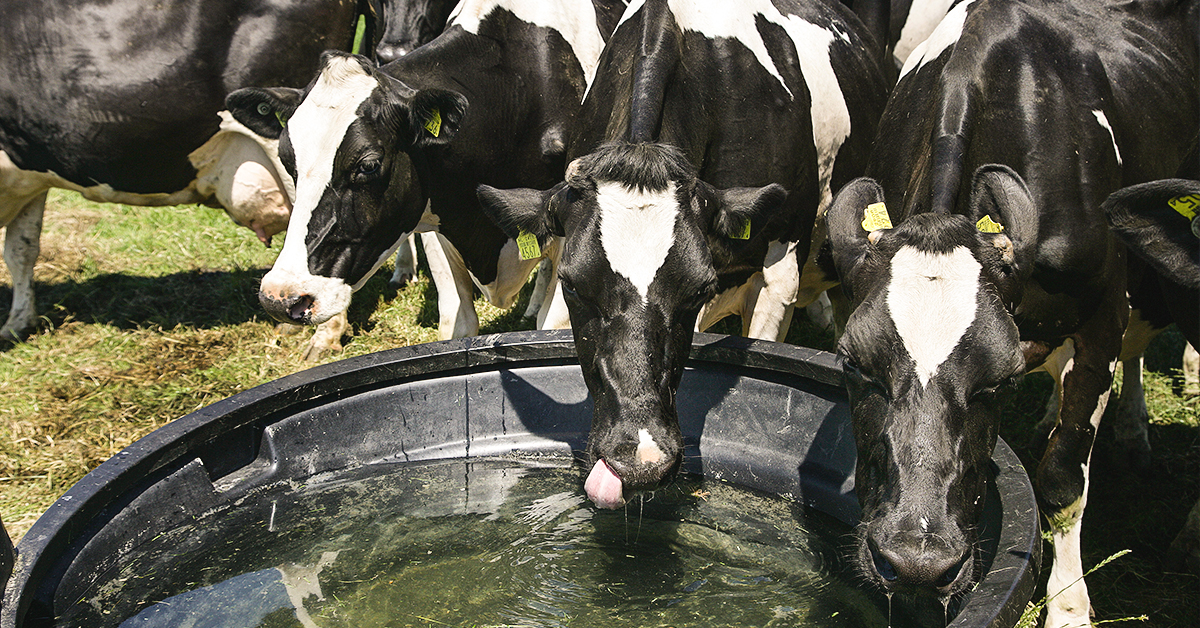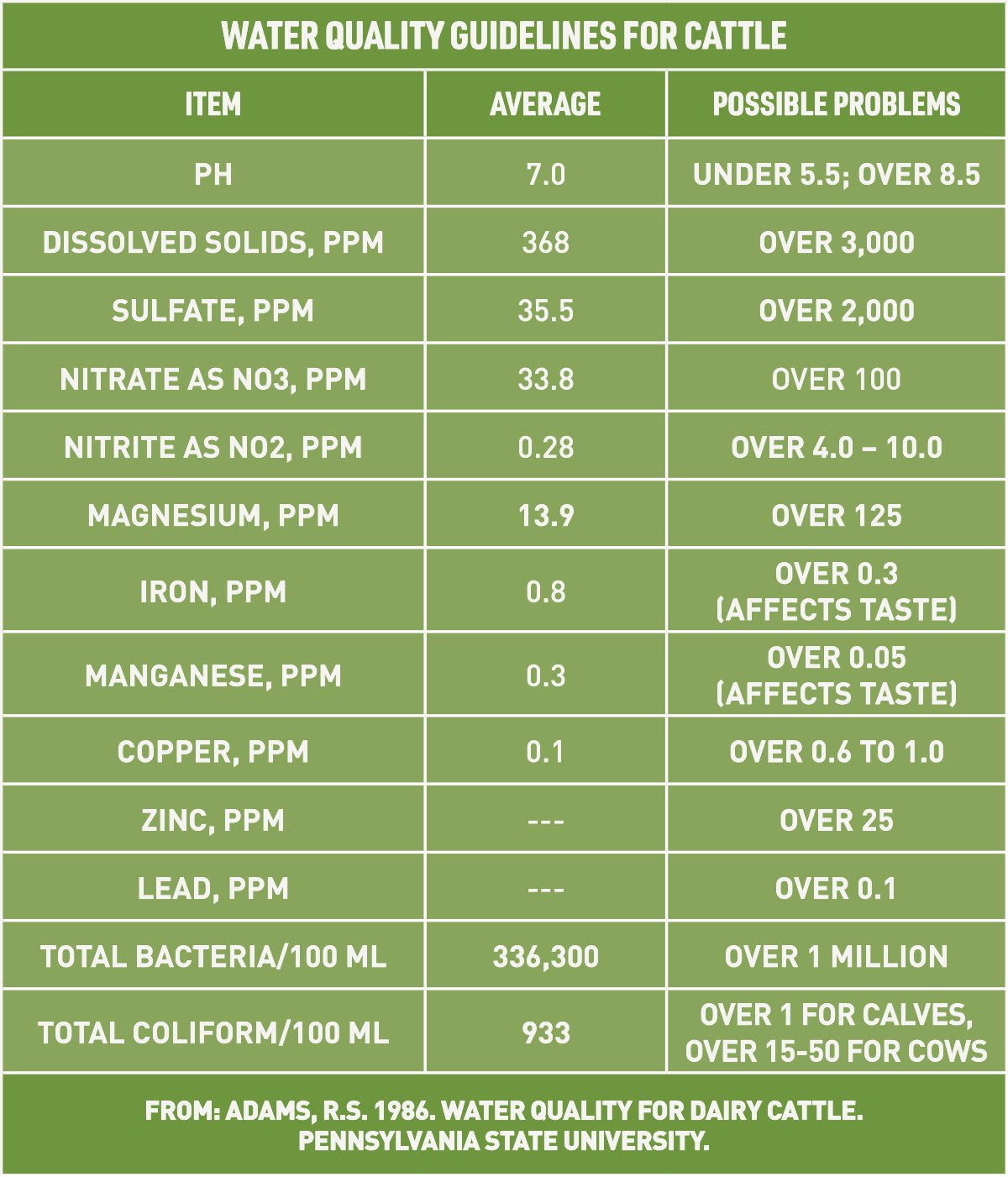
Oftentimes, with the development and advances in feed technology, it is easy to get overwhelmed and forget about the core nutrients in nutrition – such as water.
Frequently, water is valued as an important component for growing crops, but we forget water’s value for livestock. Truly, water plays a crucial role in nutrition for livestock and is affected by water source and quality.
Water's Role in Nutrition
Throughout my education, every nutrition class taught me about the critical role of water in nutrition. Water is vital in almost all life processes as the body is comprised of about 75 percent water. These processes include digestion and transport of nutrients, milk production, growth, elimination of waste products (i.e. gases, urine, and feces), aiding in body temperature regulation by eliminating or maintaining heat, and by providing an environment conducive for growth for a fetus.
Water Intake
Animals can get their water from three sources: water in feed, drinking water, and water created during the metabolism of nutrients. Water created during metabolism contributes minimally to total water requirements for the animal. Contribution from feed for total water consumption is highly variable depending on the feed source. Ultimately, the majority of the water consumed by the animal comes from drinking water.
Water intake is highly variable and is affected by stage of production, physical activity, feed type, environmental temperature, social stressors, and water system. Milk production can increase the water requirement by 50 to 70 percent. Water requirement from physical activity can increase from 20 to 300 percent. Feed components may also increase water intake, including protein, salt, sodium bicarbonate and forage type.
Importance of Water in Different Seasons
Although water is important at all times of the year, during summer when temperatures rise and animals are heat stressed, it is especially crucial. Water provides the means to transfer heat from the body into the environment (i.e. sweating, and panting). A temperature increase from 64 to 86 degrees Fahrenheit can increase water consumption by nearly 30 percent in cattle. Providing cattle with shade during periods of heat stress can reduce the amount of water needed. During winter months with cold temperatures, water can act as insulation with its high capacity for heat and thus, conserve body heat.
Impacts of Limited Water Intake
Limiting water intake usually leads to decreased feed intake in livestock. In cattle, a small water restriction during lactation may decrease feed intake by 1 to 2 pounds, and decrease milk production by 2 to 5 pounds per day. Water intake usually peaks around the same time that feed intake peaks. With ample space and time, livestock usually alternate between consuming feed and drinking water. Longer distances between the feed bunk and watering troughs may reduce water intake.
Water systems play an important role with less dominant animals. With large troughs, less dominant animals may have a greater opportunity to be able to drink water and ultimately be more productive.
In calves, water plays an important role in rumen development as it provides a medium for growth of rumen microbes. Calves offered free access to water early in life tend to have better performance compared to calves without water. However, calves are more sensitive to water and if solids are high, it may negatively affect intake and growth. Fresh, clean water is the best option when feeding young calves.
Water Quality
Odor, taste, heavy metals, minerals, bacteria, hardness, pH, stray voltage and cleanliness affect water quality. High mineral levels in water may antagonize mineral absorption. For example, water high in sulfate and magnesium may increase required amounts of copper, selenium and vitamin E in the ration. High levels of iron may increase copper requirements. Total solids in water affect the palatability of water and total amount of water consumed by an animal. Water quality is also affected by pH. In cattle, a pH less than 5.5 can increase the risk of acidosis and a pH greater than 8.5 may increase problems associated with alkalosis. Hence, either high or low pH can negatively affect your livestock.
Clean water promotes feed intake, digestion, nutrient absorption and normal rumen function. The cleanliness of troughs is often overlooked for animals. Unclean troughs may contain bacteria such as salmonella and E. coli, which can be harmful to animals, particularly young stock. Frequent cleaning of watering troughs may reduce bacterial growth.
Stray Voltage
A less known factor in water quality is stray voltage. Animals are more sensitive to stray voltage than humans, which may cause animals to avoid water. Normally, when stray voltage reaches 3 to 4 volts, cattle will refuse to drink water. At times when stray voltage is at one-half volt, water consumption has been limited which ultimately decreases animal performance.
Water for the Win
Next time you walk by your watering trough, water buckets for calves, or automatic waterers, please consider checking it and making sure that the water is clean to help improve the quality for your animals.
In addition, an annual water test is highly recommended. The embedded table provides some basic guidelines on water quality but please feel free to contact your IFA feed & nutrition advisor to help check the water quality on your operation to help achieve the optimal level of production.
Discover IFA Feed & Nutrition Services

Written by Jared Judy, PhD, and originally published in the IFA Cooperator magazine (vol. 84, no. 3) Fall 2018. Jared is an IFA Feed Nutritionist at North Region Feed.


